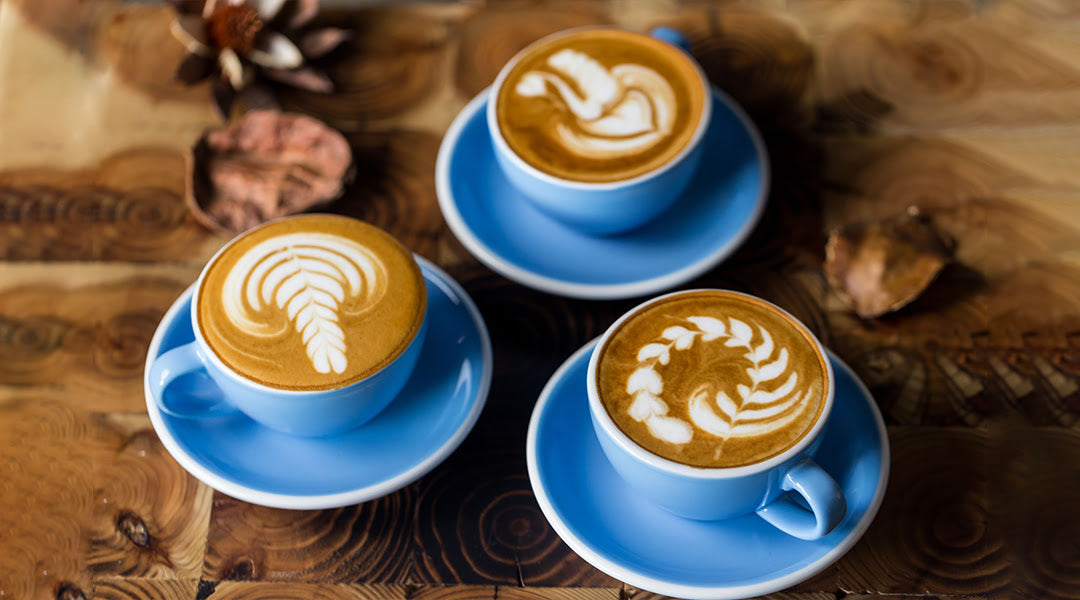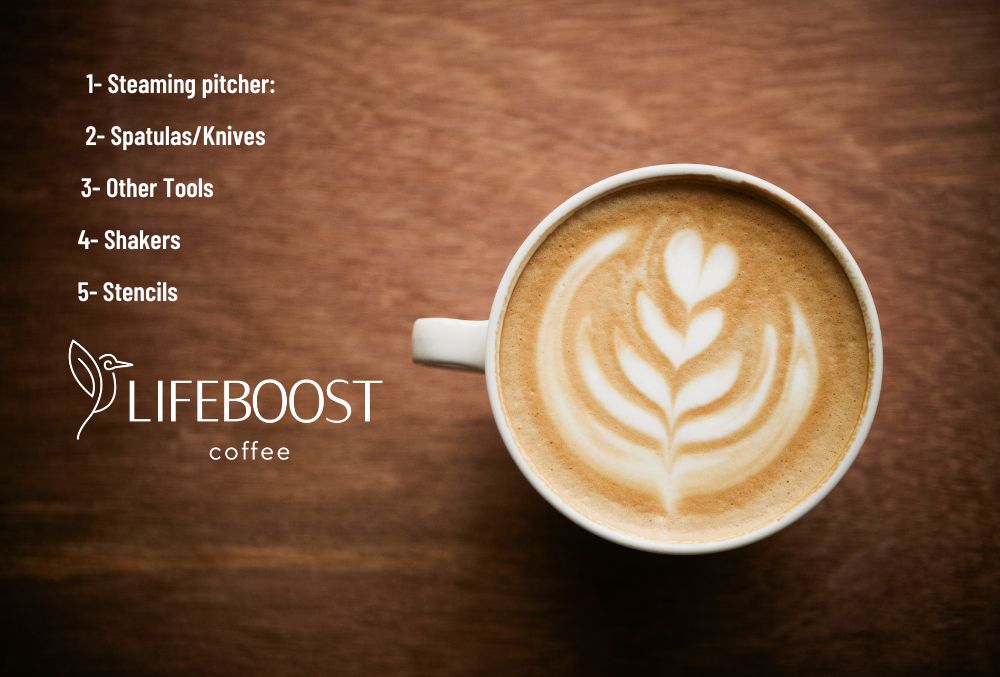
How It’s Made - From The Art Of The Cappuccino To Cappuccino Art
We enjoy drinking coffee for the health benefits it brings to our bodies.
We enjoy drinking coffee because of its fabulous flavor.
Some of us even need coffee to boost our energy levels to make it through the day.
But, there’s another reason so many of us enjoy a tasty cup of coffee…aesthetics!
The way our coffee looks, the aesthetics of our brew, matters greatly when enjoying the perfect cup.
Don’t think appearances are that important when it comes to enjoying a mug or two?
How many of you enjoy watching videos of coffee being prepared? Or, how many of you enjoy taking photos of your perfectly concocted brew? Those videos and pics are mesmerizing, right!
Well, what our coffee looks like can also greatly influence how we enjoy what’s in the cup.
We know this is true with a meal, and any chef will tell you, aside from preparation, it’s all about presentation!
The same is true of coffee.
I mean, sometimes we like to add a mound of whipped heavy cream to a hot or iced brew simply for the look, with the added flavor only serving as a fringe benefit.
But, when it comes to cappuccino or latte art, this truly takes a mound of whipped cream topping to the next level.
Cappuccino art adds an aesthetic element to an already tasty brew which is not only inviting, but intriguing as well.
So, today we’d like to explore all things cappuccino, from this drink’s origins and history to how beautiful cappuccino art is made, and ultimately how you can make the perfect cappuccino at home.
The Art Of The Cappuccino

What is a cappuccino?
That doesn’t exactly sound like a complicated question, especially for espresso lovers. But, depending on the era and location, this now-common coffee fan-favorite can mean a variety of things.
Nowadays, those familiar with the drink are well-aware of its components as the cappuccino traditionally, and perfectly, balances two ingredients, espresso and milk.
Modern day baristas sometimes do a 1:1 ratio with espresso and steamed milk, yet an authentic, traditional cappuccino technically calls for a 1:1:1 ratio of espresso, steamed milk, and milk foam.
But, when and where did the cappuccino originate, and how is this beverage enjoyed around the world?
The name cappuccino actually comes from what is called the Kapuziner, a drink commonly served in Viennese coffee houses in the 1700’s.
An 1805 description of the Kapuziner is much different, however, than the beverage we enjoy today.
While spices were sometimes added to this drink, the original Kapuziner was simply coffee served with cream and sugar.
And, though the name Kapuziner does sound like it led to the modern term ‘cappuccino,’ the true origin of the contents of a cappuccino cup are generally attributed to Italian baristas, or baristi.
Why?

Because, it was here (Italy) in the early 1900’s, shortly after the invention of the espresso machine, that the first cappuccino was thought to be served.
You see, when the espresso machine was first invented, due to its big and bulky size, it wasn’t exactly fit for in-home coffee creations. Instead, such machines were only found in specialty cafes where baristi served espresso shots and espresso based drinks.
Cappuccini (as our Italian friends would call a cappuccino) soon became quite popular, fitting the relaxed Italian culture where folks enjoyed sitting around in cafes for hours at a time, enjoying life alongside an espresso, cafe latte, or cappuccino.
But, even then, cappuccinos were very different from today’s offerings, as these drinks were commonly topped with whipped cream and cinnamon or chocolate shavings.
It wasn’t until after World War II, as espresso machines became more common throughout Italian cafes, that the cappuccino began to resemble that which we routinely enjoy today.
And, while some parts of the world still know cappuccinos as an espresso based drink topped with whipped cream and other additions, especially in American cafes, cappuccinos are classically, and commonly, known for their light, airy, sometimes even described as fluffy, white foam that rests atop a perfectly pulled shot (or two) or espresso with steamed milk.
Wait…aren’t most barista-inspired espresso drinks served in a similar manner…espresso topped with steamed or foamed milk?
While this is true, the variations of espresso based drinks often come down to how the milk component of these beverages is prepared and added.
To illustrate, let’s examine five of the most common espresso drinks which incorporate steamed milk or milk foam.

Caffe Latte - A caffe latte, or simply stated, a latte, is made with a 1:2 ratio of espresso and steamed milk.
In a latte, you’ll generally enjoy a few shots of espresso topped with 4-6 ounces of steamed milk, all resting under a thin (roughly 1 cm) layer of microfoam.
For those who enjoy sweet coffee drinks, lattes are also routinely served with flavored syrups.
You’ll commonly find such beverages topped with a dusting of cocoa powder or cinnamon as well.
Flat White - A flat white is very similar to a cappuccino in that it incorporates espresso and steamed milk, yet this offering warms the milk a bit more and has a thin layer of foam resting on top.
With only a thin layer of foam on top, a flat white has a more pronounced coffee flavor than a latte or a cappuccino.
Mocha - As the name suggests, a mocha incorporates chocolate in its making.
Instead of simply combining espresso and steamed milk, a mocha begins with chocolate which is generally topped with one shot of espresso and steamed milk.
The addition of chocolate to this drink is said to cut the bitterness of espresso, resulting in a creamy and sweet sip.
Cortado - A cortado is a Spanish coffee beverage consisting of equal parts coffee and steamed milk.
Unlike the above selections, a cortado doesn’t utilize more than a tiny, thin layer of microfoam. Instead, a single shot of espresso is topped with a single ounce of steamed milk, then finished off with typically less than a centimeter-thick layer of microfoam.
Cappuccino - And, before we move on in greater detail concerning our featured drink, the cappuccino, let’s see how this beverage compares to the other selections in this list.
A cappuccino differs from other espresso based drinks in that it tends to be much creamier and soft.
This smooth taste and texture is due to the 1:1:1 ratio used in its making.
Cappuccinos typically begin with 1-2 shots of espresso. Then, the drink is topped with equal parts steamed milk and milk foam. So, if you begin with 1 shot, or 1 ounce, of espresso, you’ll want to use 1 ounce of steamed milk, and 1 ounce of milk foam to top your cappuccino.
However, many cafes use 2 shots of espresso when making a cappuccino, meaning such renderings would then be topped with 2 ounces of steamed milk and 2 ounces of milk foam.
Now, let’s move on, going a little deeper into the world of cappuccino art, and the art of the cappuccino…
Cappuccino Art & More

Most of us are familiar with latte and cappuccino art, and we’ll get to the ins and outs of that in a moment, but did you know there’s also an art to ordering a cappuccino…especially when you visit cafes outside of the US.
In their home country, Italy, cappuccinos are morning time staples.
In fact, some would even say a true “breakfast of champions” in Italy is not cereal, eggs, or bacon, but a cappuccino!
And, mornings are typically the only time of day you can order a cappuccino in a cafe, so if you’re visiting this beautiful region, you can expect most cafes to stop serving cappuccinos after lunch.
Thankfully, lunchtime typically isn’t until 1:00 pm in Italy, and many Italian baristas recognize, and accommodate, the fact that Americans enjoy cappuccinos at all hours of the day. But, should you be denied this rich, creamy coffee creation after 1:00, you’ll know why.
Then, what about cappuccino art?
While Italian baristas have cappuccino-making down to a science, the flare and detailed creations often topping these classic beverages is most commonly seen elsewhere.
This is mostly because a true cappuccino doesn’t contain enough milk foam to create the fabulous art many have grown to love as a creamy topping for this drink.
Both latte and cappuccino art require that a little extra velvety milk foam is added to the top of the combination of espresso and steamed milk for these masterpieces to come to life, and that’s why most (not all, obviously) cappuccino art creations are found outside of Italian cafes, specifically in Asia, Nordic European regions, and the United States.
Since lattes contain less milk foam, topped only with a thin shiny layer of microfoam, latte art typically consists of designs or patterns made within the milk or foam of the drink.
And, with a greater amount of steamed milk in a latte, more intricate designs can be created in such drinks as well.
Cappuccinos, on the other hand, contain an equal amount of steamed milk and milk foam, and with this thick layer (foam) resting on top of the beverage, artwork made from this foam is generally more raised or structural in nature.
When receiving an artistic and aesthetically pleasing cappuccino, or when making one at home, there are a few common tools and trade tricks often incorporated to create such masterpieces.

First, there’s the tools…
1- Steaming pitcher: A steaming pitcher is a must when making cappuccino art. This is because the milk used to make the foam that rests atop a cappuccino isn’t simply whisked or frothed. Instead, foam for cappuccinos is steamed.
A steaming wand will infuse air and heat into the milk which creates tiny bubbles that give the foam the proper texture and stability needed for creating your cappuccino artwork.
The steaming pitcher also serves as a vessel for which you can pour the milk and foam onto your prepared espresso. Just make sure your pitcher has a pourable spout (most do).
2- Spatulas/Knives: A spatula or a flat-edged knife is often used by baristas to sculpt or manipulate the milk foam into creative shapes and structures.
3- Other Tools: Pointed tools such as etching needles or even toothpicks are commonly used by baristas to not only move or manipulate the milk foam on a cappuccino, but these can also be used to make specific, intricate, and elaborate designs in the foam.
4- Shakers: Shakers, or dusters, are sometimes used when making cappuccino art to dust cocoa powder or cinnamon, etc on top of the finished artwork to add color, depth, and of course, flavor.
5- Stencils: Stencils can be used in cappuccino art in conjunction with spices and powders, as you can place a stencil above the structure, or art, made from the cappuccino foam.
Then, when you sprinkle the cocoa powder or cinnamon, for instance, over the stencil, this creates beautiful patterns in the foam.
Now for the tricks…

As we’ve already mentioned, cappuccino art is typically made in the fluffy foam that rests atop this drink, and since the medium for this art is indeed cloudlike, the techniques or tricks incorporated in constructing such designs tend to differ a little from those used when making a latte.
When making cappuccino art, baristas typically use one or all of the following methods:
1- Sculpting: Baristas (or at-home cappuccino art enthusiasts) sometimes mold or shape the milk foam of a cappuccino into animal shapes, leaves, and more. This can be achieved using any number of the tools mentioned above, resulting in beautifully complex three dimensional artwork.
2- Layering: To achieve depth and dimension, you can add several layers of milk foam to a cappuccino which allows for a wide variety of designs to be made in the foam.
3- Dusting: Sometimes cappuccino art is simple, yet incredibly beautiful, as it incorporates the use of stencils (as mentioned above).
When using a stencil, you can take a simple layer of foam and transform it into a magnificent picture, or you can elevate animals, figures, and other foam sculptures by dusting on a bit of cinnamon or cocoa powder through a stencil for the perfect finishing touch.
So, now that we’ve detailed most of the whats and the whys, let’s move on to the cappuccino how-tos.
Making The Perfect Cappuccino

Our exploration of the cappuccino wouldn’t be complete without a quick tutorial to close out our time here today.
So, if you’d like to make a truly delicious, and beautiful, cappuccino at home, here’s a simple guide to doing so:
To make the perfect cappuccino at home, you’ll need a quality espresso machine, Lifeboost Espresso Coffee, and whole milk.
Whole milk is recommended for making the smoothest, most velvety foam for a cappuccino, but your personal milk preference is fine as well (just note that the texture and possibility for making cappuccino art diminishes with some milks).
First, we suggest beginning this process by adding hot water to the mug or demitasse you’ll be sipping your cappuccino from.
This extra step, prior to preparing your beverage, will keep your cappuccino warm for a longer period of time, and most importantly, it means you won’t need to warm your milk as much, allowing the sweetness of the milk to come through a bit more as you sip.
Next, you’ll want to prepare your ground espresso beans for the portafilter.
Make sure your portafilter is clean and dry, then we recommend using a digital scale to precisely measure the coffee.
Weigh out roughly 20 grams (18-21 is the standard rule) of coffee, finely grind the beans, then add the ground coffee to the basket of the portafilter.
You’ll want an even distribution of coffee in the basket, so be sure to level out the grounds until the surface is even.
Next, you’ll want to use the tamper to compress the coffee into the portafilter basket.

So, make sure the portafilter is level, then bring the tamper straight down onto the surface of the grounds, pressing down evenly on the coffee in the basket to compact it. You’ll want to examine carefully here to make sure the tamper is even, or level, on the grounds, so the water in the espresso machine goes through the grounds at a consistent rate (not too fast or too slow).
Now, lock the portafilter into the espresso machine, and begin to pull a double shot of espresso.
If you have a timing option on your espresso machine, 30-35 seconds is said to be a sweet spot to ensure your espresso is rich and full without any sour or bitter taste.
Once your espresso is pulled, add ice cold milk to your steaming pitcher, filling to a little under ⅔ full.
Then, insert the steaming wand just into the surface of the milk in the pitcher. Putting the wand only into the surface allows it to “whip” in the air to create the perfect texture for a cappuccino.
As you steam, once you’ve gotten the texture you desire, lift the pitcher up (which inserts the wand deeper into the milk) to raise the temperature of the milk without disturbing the texture created on the surface.
Overall, this process shouldn’t take more than 6-8 seconds.
Now, tap the base of the pitcher on the counter and give it a little swirl to polish the prepared milk.
Holding the pitcher a few inches above the espresso, pour in enough milk to fill the mug about halfway, swirling as you pour to fully incorporate it into the espresso.
Next, lower the pitcher all the way to the surface of the espresso, and tilt the demitasse or mug about 45 degrees (towards you). Pour the milk foam into the center of the mug, moving (some call this jiggling) the pitcher to the left and right, or in a circular motion out towards the rim of the cup.
Of course, if you’ve ever tried your hand at cappuccino art, you know this takes much practice. So, if you’re attempting a specific design, do you research and grant yourself an abundance of patience and grace, enjoying the process as you channel your inner barista.
Check out Lifeboost Coffee Espresso.

Becky is a mother, educator, and content writer for Lifeboost Coffee. She has had three years’ experience as a writer, and in that time she has enjoyed creatively composing articles and ebooks covering the topics of coffee, health and fitness, education, recipes, and relationships.
- https://baristaandco.com/blogs/news/why-latte-art-important
- https://www.thespruceeats.com/history-of-the-cappuccino-765833
- https://methodicalcoffee.com/blogs/coffee-culture/what-is-a-cappuccino-and-how-do-you-make-one
- https://pullandpourcoffee.com/the-6-most-popular-espresso-coffee-drinks/
- https://www.lacucinaitaliana.com/italian-food/italian-dishes/the-art-of-cappuccino?refresh_ce= https://www.ibs.coffee/post/is-latte-art-widespread-in-italy
- https://www.baristainstitute.com/inspiration/history-and-basics-latte-art
- https://majestycoffee.com/blogs/posts/cappuccino-art-vs-latte-art
- https://www.honeybeecoffeeco.com/blog/2023/4/11/cappuccino-vs-latte-whats-the-difference
- https://bluebottlecoffee.com/us/eng/brew-guides/espresso
- https://www.illy.com/en-us/coffee/coffee-preparation/how-to-make-cappuccino
- https://www.youtube.com/watch?v=gvPetTPFsZM
- References for the article to confirm data and information.







